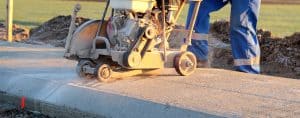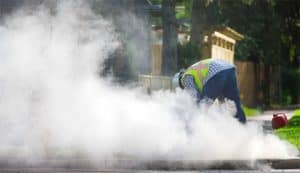Quartz, cristobalite, and tridymite walk into a bar…
Sorry, we haven’t figured out the punchline yet, but now that we have your attention, it’s time to talk about silica.
 If you aren’t already aware, OSHA is now enforcing most provisions of its respirable crystalline silica standards for construction as of September 23, 2017, and will begin enforcing many standards for general industry on June 23, 2018.
If you aren’t already aware, OSHA is now enforcing most provisions of its respirable crystalline silica standards for construction as of September 23, 2017, and will begin enforcing many standards for general industry on June 23, 2018.
Ready to learn how Table 1 can help you keep workers safe? Pull up a bar stool and let us tell you more.
What is Table 1? Table 1 is a tool under the new OSHA silica standard (1926.1153) that helps employers reduce employee exposures to respirable silica dust. Table 1 lays out equipment being used in the construction field, engineering and work practice control methods, and respiratory protection that must be worn with assigned protection factors (APF) while completing these tasks. It also includes information about PPE that’s divided into two categories: less than or equal to four hours per shift and greater than four hours per shift.
How do I use Table 1? To use Table 1, the employer simply has to find the equipment employees are using in the field on the table, implement the engineering and work practice control methods on the table (if they haven’t been implemented already), and implement the respiratory protection specified for the task or equipment being used. For tasks NOT included in Table 1, the employer must ensure that no employees are exposed to respirable silica above the OSHA PEL of 50 ug/m3 by means of air sampling.
What is included in Table 1? OSHA’s Table 1 lists 18 different silica-generating tasks along with specific engineering controls and requirements for respiratory protection to achieve compliance. These tasks include stationary masonry saws, handheld power saws, handheld grinders, jackhammers and handheld chipping machines, etc.
Let’s Test It Out with A Few Scenarios
Alright, let’s say your company is using a stationary masonry saw to cut concrete block. The saw is already equipped with an integrated water delivery system and is well maintained. Using table 1, you would first find the equipment/task on the left, then look at the middle column for engineering controls. The last step is to follow the row to the far right and look under the required respiratory protection column and you’ll see that no respiratory protection would be required for this scenario.
How about another example? If you’re using a handheld power saw, regardless of the diameter of the blade, respiratory protection varies for indoor use and outdoor use. For greater than four hours, you can see that according to the table, both will require a respirator with an assigned protection factor of 10 (P100 dust mask or half face respirator with P100 filters). For less than or equal to four hours, outdoor use does not require a respirator but indoor use requires a respirator with an assigned protection factor of 10.
 Can I get a recap?
Can I get a recap?
- Table 1 can be found under the OSHA standard 1926.1153.
- Table 1 lists 18 silica-generating tasks along with respirator requirements and engineering controls.
- Some tasks vary from indoor and outdoor use.
- Respirator requirements vary between less than or equal to four hours per shift and greater than four hours per shift.
If we wet your whistle with this info but are still thirsty, join us for some new silica training opportunities
Grab a Spot at Silica Training
Contact us for training opportunities.
Supervisor Training Available Too
We’ll be holding an implementing the new silica standard class in May. You’ll walk away from this class with a customized written exposure plan. Register here.
